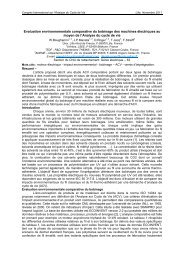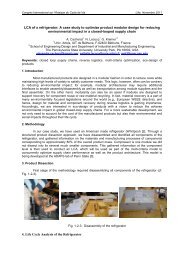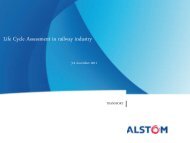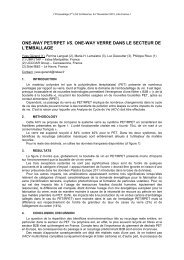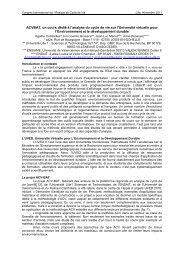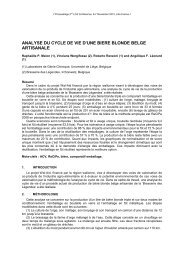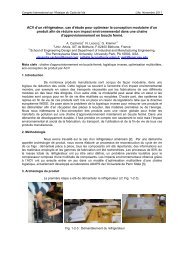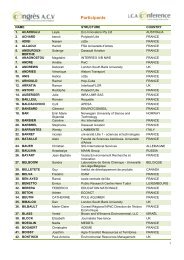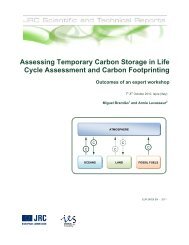Untitled - avniR
Untitled - avniR
Untitled - avniR
Create successful ePaper yourself
Turn your PDF publications into a flip-book with our unique Google optimized e-Paper software.
Congrès International sur l’Analyse du Cycle de Vie Lille, Novembre 2011<br />
COMPARATIVE LCA FOR TWO NATURAL INSULATING MATERIALS ON A WALL<br />
Jean-Luc Menet*, Etienne Bocquillon, Emilie Decosse<br />
Université Lille Nord de France, ENSIAME, UVHC, 59313 Valenciennes Cedex<br />
* jean-luc.menet@univ-valenciennes.fr<br />
Introduction<br />
As regards to thermal insulation, straw bundles and linseed panels seem to be ecological at first<br />
sight. The advantage of these materials is that their farming does not require specific cultivation areas,<br />
because they are made from agricultural wastes. Straw is in fact an excess production in conventional<br />
farming, and the linseed panels manufacturing uses short fibers that cannot be transformed by textile<br />
industry.<br />
The aim of the present study is to quantify environmental impacts using an exhaustive Life Cycle<br />
Assessment of these two ‘natural’ products integrated on a wall, relatively to the ISO 14040. The results<br />
are compared to a conventional insulated wall<br />
Goal and scope of the study<br />
The final goal of the study is to compare two types of insulated walls the area of which is 15 m² (3<br />
m high vs 5 m long), with a wood structure.<br />
To be called “passive house”, the thermal transfer coefficient of each wall must not exceed 0.15<br />
m 2 .K/W, which deals to a thermal resistance of about 6.5 W/m 2 .K for the wall. Thus the functional unit has<br />
been chosen to be the insulation of a wall during 100 years with a thermal resistance of 6.5 W/m².K. The<br />
keys parameters are the thickness of insulating materials which must be chosen to obtain the correct<br />
thermal resistance, and their shelf life. For the calculation of the insulation, only the insulating material will<br />
be considered.<br />
In our study, the following steps of the life cycle are considered: raw material procurement and<br />
manufacturing, the distribution, the consumer use, and the end of life (post-consumer use).<br />
Presentation of the two natural insulating materials<br />
1 Insulated wall with straw<br />
There are many possibilities to use straw for insulating. We have chosen the GREB straw ball<br />
building technique [1]. The wall is composed of three elements represented on Figure 1.<br />
To build a wall of 3m high and 5m long using straw bundles, the following quantities of materials<br />
must be used: 30 straw bundles, 4 beams of 5m long, 16 beams of 2.86 meters long, 40 brackets of 0.35m<br />
long, 0.96 m 3 mortar, 240 steel nails, and 273 m string.<br />
2 Insulated wall with linseed panels<br />
A fast study of the thermal conductivity of linseed shows the for the linseed panels insulating wall,<br />
the isolating material thickness must be around 21cm. A 20cm thickness is chosen because it can be<br />
found for sell. The insulation is made using the elements shown on Figure 2.<br />
Bracket<br />
Beam<br />
Straw bundles<br />
Wood board<br />
Linseed panels<br />
OSB<br />
Mortar<br />
FIG. 1 – Structure for straw insulation<br />
FIG.2 – Structure for linseed insulation<br />
- 61 -



